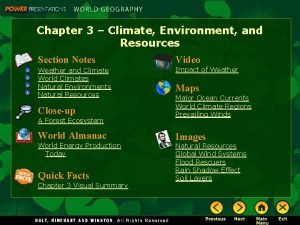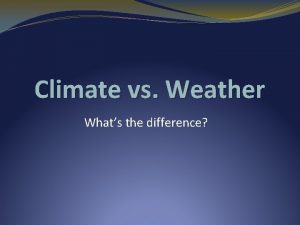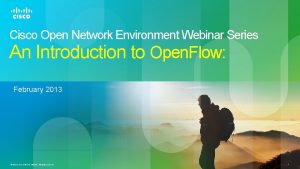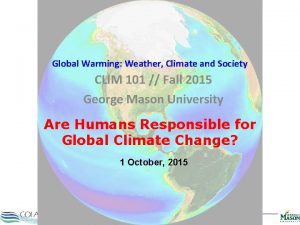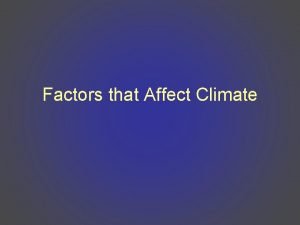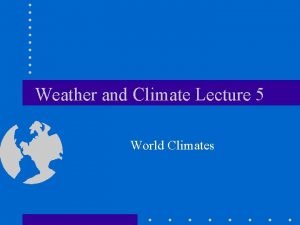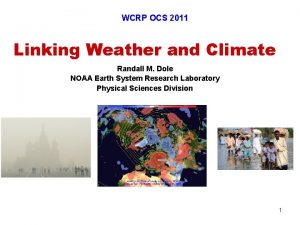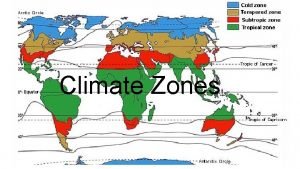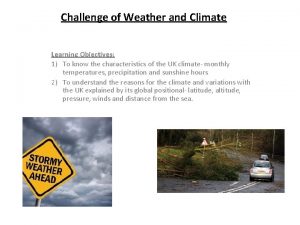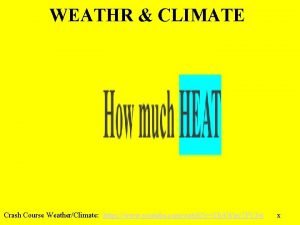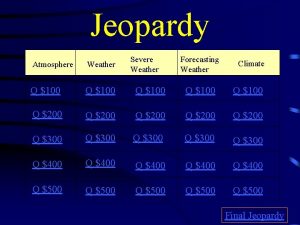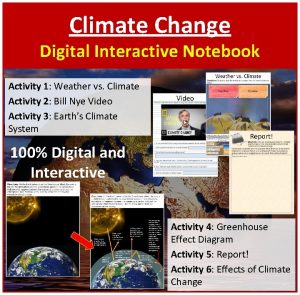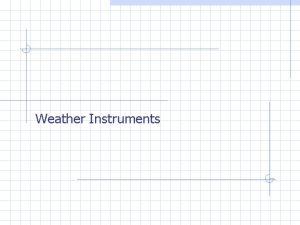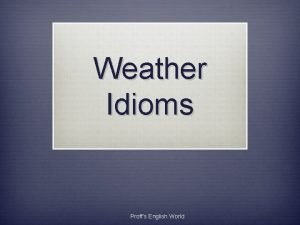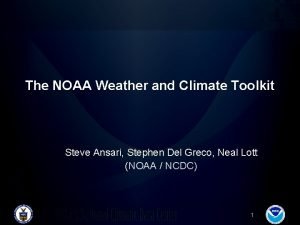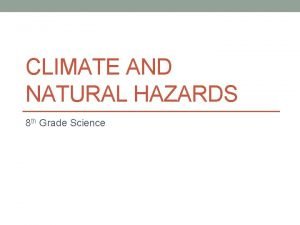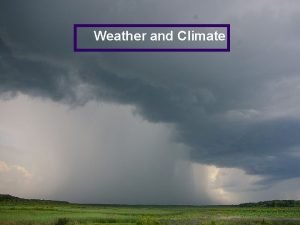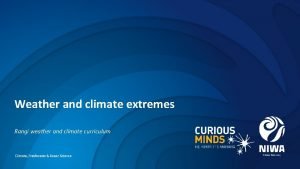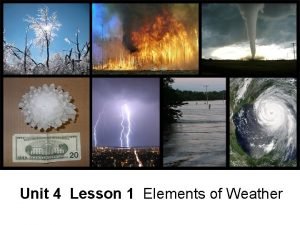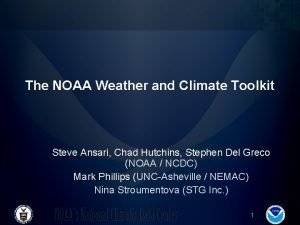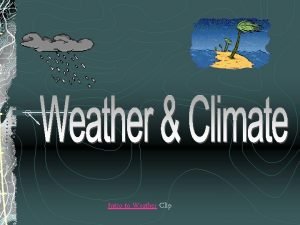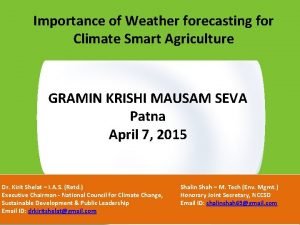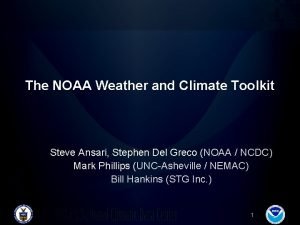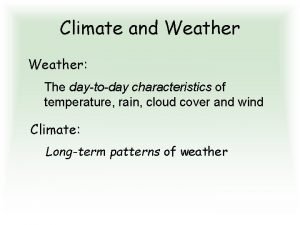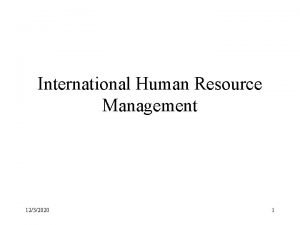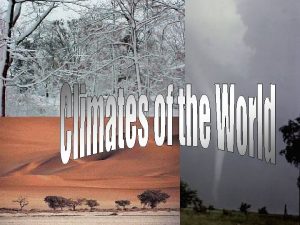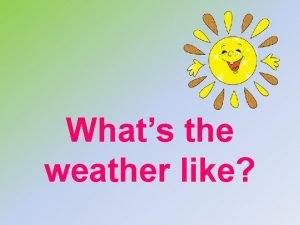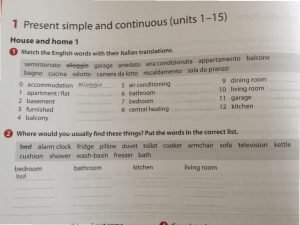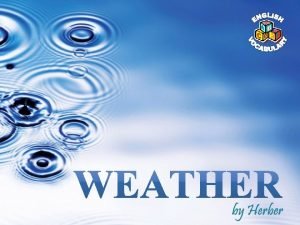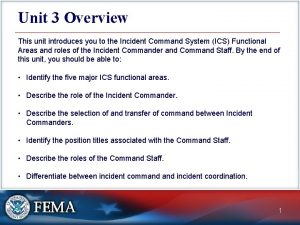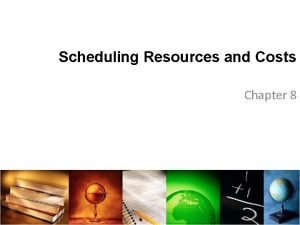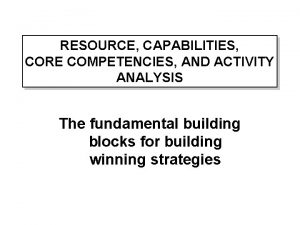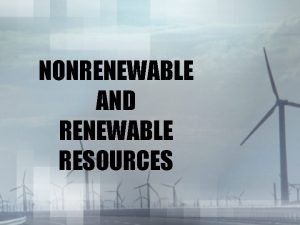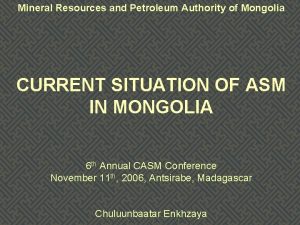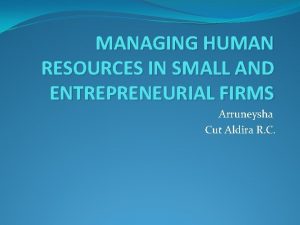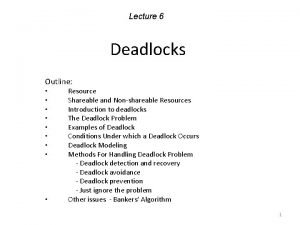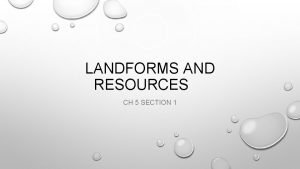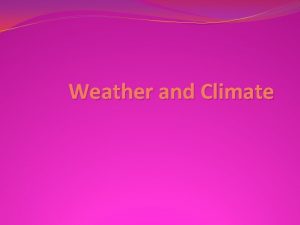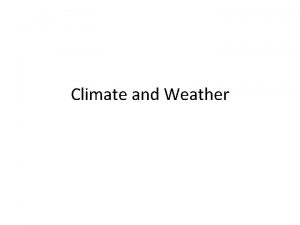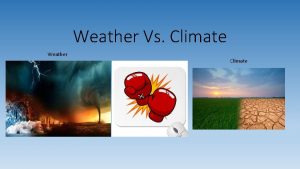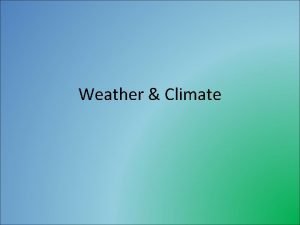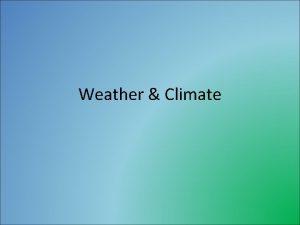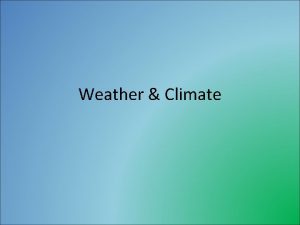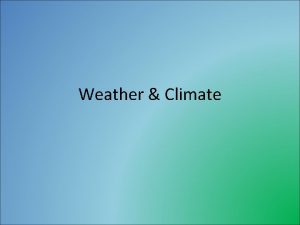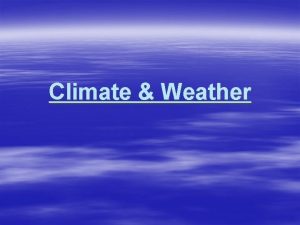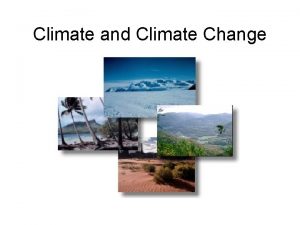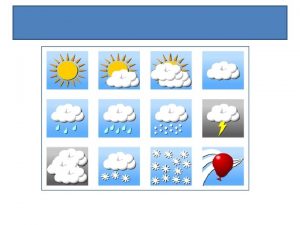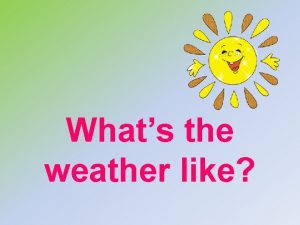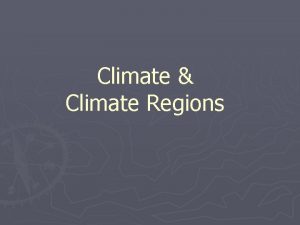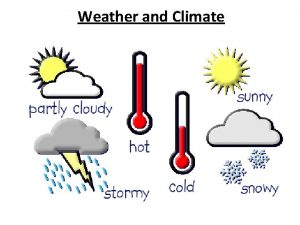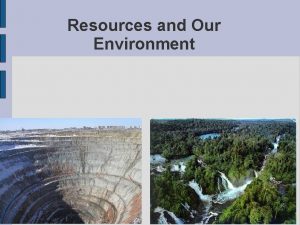Weather Climate Environment Resources Weather and Climate Whats



























































- Slides: 59

Weather Climate Environment Resources

Weather and Climate What’s the difference? (Answer on Board. . . )

Assignment Create a ’weather report’ (10 Points) What is the weather going to be like tomorrow and this week? –Using the information we covered in class explain our current weather situation. – Use these terms, that apply, when describing our weather… • Sun & Location! • Wind! – Prevailing Winds… • Water! – Ocean Currents – Large Bodies of Water… • Weather Fronts! • Mountains! – Rain Shadow Effect… Answer in complete sentences! (ALSO – CORRECT HEADING!)

BRAIN CHECK • What is weather? • What is climate?

What cause our weather & climate? What is it like outside? Weather – Short-term changes in the air for a given place and time… • Temperature and Precipitation from hour to hour or day to day… Climate – A regions average weather condition of a long period of time… • Based on data and experience… – May? December? What creates weather and a place climate? The factors that shape weather and climate include the sun, location on Earth, wind, water, and mountains… (How? )

Sun and Location The sun energy heats our planet. (Solar Energy!) • Different areas receive more or less depending on the Earths, latitude & tilt? Earths shape also effects weather and climate. • Low Latitudes (Equator) –More sunlight. • High Latitudes (Poles) – Less sunlight. • Tilt!

Wind and Water How does heat from the sun move across the Earth’s surface? • Air and Water warmed by the sun are constantly moving around the Earth… – These carry heat from place to place! • As a result, they make different areas of Earth warmer and cooler… These effect a places weather and climate!

Global Winds Wind (air) constantly blows around our planet… – This movement of air blows in great streams around the planet… • Prevailing Winds – blow in the same direction over a large area… – Trade Winds, Westerlies, and Polar Easterlies…

Global Winds To understand Earth’s wind patterns you must think about the weight of the air… • Weight changes with temperature… – Cold Air – sinks! & Hot Air – rises! • On a global scale, this rising, sinking, and flowing air creates Earth’s prevailing winds. – Earths rotation causes prevailing winds to curve east to west… • These winds can cool and heat a region, as well as make it drier or wetter…

Ocean Currents – large streams of surface seawater. • Move heat around Earth… –Wind HELPS drive these ocean currents… • Warm Currents – Raise Temperature • Cold Currents – Lower Temperature Gulf Stream –Warms U. S. East Coast!

Large Bodies of Water Large bodies of water also affect a regions climate… –Oceans, Lakes, and Gulfs… • Makes temperature in area a lot milder, as well moisture…

Wind, Water, and Storms Most major storms occur when two air masses collide… –Front – a place where two air masses or different temperatures meet. –Rain/Thunderstorm –Snow Storms –Icy Blizzards –Monsoons –Tornados –Hurricanes • 155 mph winds and 17 ft. storm surges… –Typhoons • Hurricanes in the Pacific Ocean…

Mountains? Rain Shadow Effect? Most of the moisture in the ocean air (front) falls on the mountainside facing the wind. Little moisture remains to fall on the other side, creating a rain shadow.


Assignment Climate Zone Map • This is not due tomorrow! • Begin working on and labeling the ‘Climate Zone’ Map… • We will continue talking and working on ‘Climate Zones’ tomorrow!


Brain Check • Themes, Sun, Water, and Landforms… • What is weather? (climate? ) • How does the sun & location effect the Earth’s weather and climate? (latitude? ) • How does wind effect the earths weather and climate? (prevailing winds? ) • How do ocean currents effect temperatures? (large bodies of water? ) • What is a front and what can they cause? • What is the ‘Rain Shadow Effect’?

Weather, Climate, Environment, and Resources • Section 1 – Weather and Climate • Section 2 – World Climates • Section 3 - Natural Environments • Section 4 – Natural Resources

World Climate Zones

World Climate Zones • In January, how will you dress for the weekend? (May? ) – In some places you might get dressed to go play in the snow… – Other places you might get dressed to go swimming… What the seasons are where you live depends on the weather and climate…

Earth is a collage of climates… Geographers identify climates by looking at… • Temperatures… • Precipitation… • Plant Life… Using these we can divide the Earth into 5 climate zones… – Tropical, Temperate, Polar, Dry, and Highland… • Based on Latitude and Elevation!

Tropical Climates Close to the Equator (Low Latitudes) Humid Tropical Climate (HOT/WET) • Warm with high amounts of rain year-round (450 inches/yr. ). –Monsoons… –Tropical Rainforest… Tropical Savanna Climate (DRY/HOT) • Warm all year; distinct rainy and dry season. –Long hot dry season, followed by short periods of rain. • Savannas – Areas of tall grasses and scattered trees and shrubs.

Dry Climates • Desert Climate (HOT/DRY) • Earths HOTTEST Climate 136 Degrees! – Sunny and dry; less than 10 inches of rain a year… • Plant life is almost impossible! • Steppe Climate (HOT/DRY) • Hot summers and cool winters with wide temperature ranges during the day… – Steppes – semidry grasslands or prairies…

Temperate Climates Temperate climates occur in the middle latitudes… – These climates have 4 distinct seasons… • Mediterranean Climate – Dry, sunny, warm summers; mild, wetter winters. (Found in coastal areas) • Humid Subtropical Climate (Hot/Wet) – Humid with hot summers and mild winters; rain year round; in path of hurricanes and typhoons. • Marine West Coast Climate – Cloudy, mild summers and cool, rainy winters. • Humid Continental Climate (OUR AREA) – FOUR distinct seasons; long winters and short warm summers; average precipitation varies. (Mixed Forest)

Polar Climate • Subarctic Climate (DRY/COLD) – Extreme of temperatures; long winters and short warm summers; little precipitation. (Evergreen Forest “Taiga”) • Tundra Climate (DRY/COLD) – Cold all year long, cool summer; little precipitation and low shrubs. • Permafrost – Permanently frozen layers of soil. • Ice Cap Climate (DRY/COLD) – Freezing cold; snow and ice; little precipitation. No vegetation!

Highland Cave Climate • Highland Climate (Mountains) – Wide range of temperatures and precipitation amount, depends on elevation and location… (Forest to Tundra's) – Varies places in the World… • Cave Climate – Temperature inside caves reflect temperatures from outside. • Soil and rock surrounding a cave moderates its temperature. – Similar to ocean currents…

ACTIVITY Climate Zone BBALL Climate Zone Map TURN IT IN! (End of

Turn in your Assignment Pick a Climate Zone and write something interesting about it! Humid Tropical Climate Tropical Savanna Climate Desert Climate Subarctic Climate Tundra Climate Steppe Climate Ice Cap Climate Mediterranean Climate Highland Climate Humid Subtropical Climate Marine West Coast Climate Humid Continental Climate

BOARD! Name One Climate Zone and a Characteristic…

• • PROJECT DIRECTIONS Students will be reporting ‘LIVE’ from one of the Worlds ‘Climate Zones’… (NARRATIVE!) Students will have to form groups of 2… Once in groups of 2, students will have to pick a ‘Climate Zone’ to research… (FRI) Groups will have to research specific facts and details about their ‘Climate Zone’… (FRI & MON) • Where is it? & What is it like? • Plants? & Precipitation? • Groups must be ‘VERY’ descriptive… (HOOK!) – Once groups have found all of their information they will have to present (1 Minute Reports) their findings to the class as if they were visiting that ‘Climate Zone’… (TUE) – Groups will have to dress up (for their appropriate Climate Zone) when presenting! (TUE) – Use strong verbs and nouns, modify them by using adjectives and adverbs! DESCRIBE YOUR CLIMATE ZONE!


Give an example of a Natural Environment?

Climate, Environment, and Resources *Section 1 – Weather and Climate *Section 2 – World Climates *Section 3 - Natural Environments *Section 4 – Natural Resources

What is an Environment? Environment What is an environment? (LANDSCAPE) *The land, water, climate, plants, and animals of an area. (Surroundings) * What do you see in your natural environment? * What makes it unique? * How is your environment special?

Limits on Life The environment limits life! *Temperature, rainfall, and soil conditions limit where plants and animals can live. * With different environment animals and plants must adapt. * All plants and animals are adapted to specific environments. * Examples? ? ?

Connection in Nature The interconnection between living things and the environment form ecosystems. *Ecosystem – is a group of plants and animals that depend on each other for survival and the environment in which they live. *Can be any size… *Can occur wherever… * Air, Earth, Water, or Soil support life.

Changes to Environment The interconnected parts of an ecosystems exist in a fragile balance… *Small changes to one part can affect the whole system… * Lack of Rain! * Deforestation! * Desertification! * Habitat – is a place where a plant or animal lives. * Extinct – extreme changes in ecosystem can cause species to die out…

Assignment – THINK/CREATE? Glaucus Atlanticus • Giant Coconut Crab Mantis Shrimp • Glass Frog Saiga Antelope • Blobfish Bush Viper • Camel Spider Blue Parrotfish • Pink Fairy Armadillo Shoebill • Maned Wolf Okapi • Irrawaddy Dolphin Narwhal • Dugong Angora Rabbit • Yeti Crab Proboscis • Superb Bird of Paradise Umbonia Spinosa • Japanese Spider Crab • Lowland • Panda Ant Streaked First Tenrec Come – First Served • • Directions • 1. Pick an animal… • 2. Research… • • What is it… • • Where can it be • found… • • Habitat… • Climate Zone… • • Answer these • questions on a blanks • piece of paper. 3. Draw/Illustrate the animals ecosystem… 4. COLOR PLEASE! 5. Questions? SS. 7. 3. 8 2007 Physical Systems: Describe ecosystems.


Environment • Weather/Climate? • Climate Zones? • Ecosystem? • Habitat? • Extinct? • Changes to our environments? • Good or Bad… • Can we stop it?

Climate, Environment, and Resources *Section 1 – Weather and Climate *Section 2 – World Climates *Section 3 - Natural Environments *Section 4 – Natural Resources

Earth’s Valuable Resources Natural Resources What are some of Earth’s valuable resources? • Renewable • Nonrenewable

Using Natural Resources Natural Resource – are any materials in nature that people use and value. . . *Air, water, soil, forest, oil, and other minerals. *Natural resources are a raw material used for our everyday products…

Types of Natural Resources Renewable Resources – are resources Earth replaces naturally… • Water, Soil, Trees, Plants, and Animals… Nonrenewable Resources – are resources that cannot be replaced… • Coal, Oil, and Natural Gas… – Once used, it’s GONE!

Renewable Energy Resources Renewable energy will never run out! *Hydroelectric Power – the production of electricity from water power! *Dams… *Wind Power – the production of electricity from wind! *Wind Mills… *Solar Power – the production of electricity from the sun! *Solar panels… *Nuclear Energy *Geothermal Energy

Mineral Resources Nonrenewable Resource *Metals (Steel and Iron) *Rocks (Granite) *Salt *Gemstones (Diamonds)

Nonrenewable Energy Resources Fossil Fuels – nonrenewable resources that formed from the remains of ancient plants and animals… • Coal, Petroleum, and Natural Gas…

Activity – Get a Cookie. LISTEN! – Step 1, Everyone will need a – – cookie… Step 2, Everyone needs a toothpick… Step 3, Try to remove the Chocolate Chips… Step 4, What happened… Step 5, results? ? ? Environment – Resources. WORTH IT? (REFLECTION…) SS. 7. 3. 9 2007 Physical Systems: Compare and contrast the distribution of natural resources.

Resources and Wealth Natural Resources affect every countries economic status! • Resource = Wealth –Oil… –Lumber… –Wind… –Diamonds… –Nuclear Energy… –Food/Plants… –Water… Negatives/Benefits of Natural Resources?



Climate – Environment Basketball l l l Be prepared to play Jeopardy Wednesday… Take Notes! Begin to study for you Test! Collect/Study Homework! Good Luck! Test Friday! (35 Points)

Chapter 3 Test Friday • 15 Multiple Choice – 1 Point Each! • 10 Matching – 1 Point Each! • 5 Essays (Choose 2) – 5 Points Each! – (Describe, Justify, Why, Explain, and Elaborate!) 35 Points Total Once finished, read Chapter 4 Section 1… Complete the assessment 1 – 4… or Complete the Chapter 4 Crossword Puzzle

Chapter 3 Test Today • 15 Multiple Choice – 1 Point Each! • 10 Matching – 1 Point Each! • 5 Essays (Choose 2) – 5 Points Each! – (Describe, Justify, Why, Explain, and Elaborate!) 35 Points Total



Environment • Weather/Climate? • Climate Zones? • Ecosystem? • Habitat? • Extinct? • Natural Resources? • Nonrenewable? • Renewable?

Answer the following question… (10 Minutes) What do you think would happen if the Worlds average temperature was raised by 6 or more degrees?

 Climate environment and resources
Climate environment and resources Whats the difference between weather and climate
Whats the difference between weather and climate Operations transformation process
Operations transformation process Fixed and variable resources examples
Fixed and variable resources examples Renewable vs nonrenewable resources worksheet
Renewable vs nonrenewable resources worksheet Cisco open network environment
Cisco open network environment Environment resources
Environment resources Climate change 2014 mitigation of climate change
Climate change 2014 mitigation of climate change World geography today
World geography today Clim 101
Clim 101 What is this
What is this Weather and climate similarities
Weather and climate similarities Conclusion of weather and climate
Conclusion of weather and climate Climate zones and weather worksheet answer key
Climate zones and weather worksheet answer key Objectives of weather and climate
Objectives of weather and climate Weathevr
Weathevr Temperate climate zone plants
Temperate climate zone plants What happens when the temperature of the air cools brainpop
What happens when the temperature of the air cools brainpop Weather and climate jeopardy
Weather and climate jeopardy Weather and climate interactive activities
Weather and climate interactive activities Instruments used to measure weather and climate
Instruments used to measure weather and climate Cloud nine idiom
Cloud nine idiom Whatever the weather poem
Whatever the weather poem Weather and climate toolkit
Weather and climate toolkit Explain how some hail can become baseball sized
Explain how some hail can become baseball sized L
L Kahoot.com
Kahoot.com 2 elements of weather
2 elements of weather Noaa weather climate toolkit
Noaa weather climate toolkit Brainpop weather
Brainpop weather Contingent crop planning slideshare
Contingent crop planning slideshare Venn diagram of active and passive voice
Venn diagram of active and passive voice Noaa weather and climate toolkit
Noaa weather and climate toolkit Climatograph of taiga
Climatograph of taiga Environment of business finance
Environment of business finance What is human resource
What is human resource Factors affecting climate
Factors affecting climate Whats hot whats not
Whats hot whats not What is the weather like
What is the weather like What's the weather like?
What's the weather like? Whats the weather in buenos aires
Whats the weather in buenos aires Weather station model examples
Weather station model examples Tongue twister about spring
Tongue twister about spring It's sunny and windy
It's sunny and windy Whether the weather is fine
Whether the weather is fine Heavy weather by weather report
Heavy weather by weather report Capital weather gang weather wall
Capital weather gang weather wall Scenario the deputy incident commander will be replacing
Scenario the deputy incident commander will be replacing Chapter 24 the land where continents collided
Chapter 24 the land where continents collided Landforms of southwest asia
Landforms of southwest asia What are the impacts of resource constrained scheduling
What are the impacts of resource constrained scheduling Resource capabilities and core competencies
Resource capabilities and core competencies Resources allocation and mobilization plan (ramp)
Resources allocation and mobilization plan (ramp) Solar energy diagram
Solar energy diagram Job expansion in operations management
Job expansion in operations management Nonrenewable and renewable resources
Nonrenewable and renewable resources Mineral resources and petroleum authority of mongolia
Mineral resources and petroleum authority of mongolia Managing human resources in small and entrepreneurial firms
Managing human resources in small and entrepreneurial firms Deadlock solver
Deadlock solver Chapter 5 section 1 landforms and resources
Chapter 5 section 1 landforms and resources
